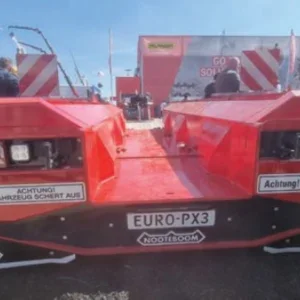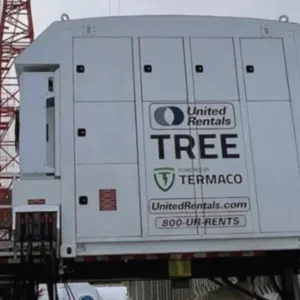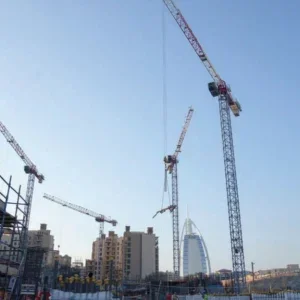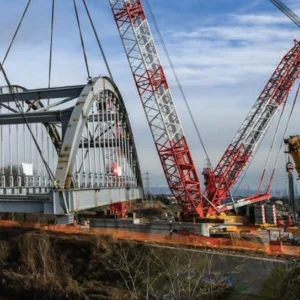he stars of the European crane and heavy haulage industry were out in force. They included several members of the Van Seumeren family of the leading Dutch company Mammoet, the Sarens brothers of Belgium’s biggest company, Martin Ainscough from the UK’s biggest, Søren Jansen from BMS, Scandinavia’s biggest, Christian-Jacques Vernazza of Mediaco, France’s biggest, and Doron Livnat of international firm Hovago, to name a few.
From the equipment manufacturers were Dick Nooteboom, a brace of Liebherr Ehingen bosses past and present Friedrich Bär and Hans-Georg Frey, the top Terex trio of Ron DeFeo and Fil and Steve Filipov, Manitowoc Crane Group’s European boss Jean-Yves Bouffault, plus senior figures from Nicolas, Tadano Faun, Kobelco and Liebherr Nenzing.
And then there were the VIPs from various government transport ministries.
The date was 31 March 2004, the Wednesday evening of the Bauma fair. The place was the Munich Hofbräuhaus. There was only space to squeeze in 150 people in the room that had been booked at late notice, but it was an impressive gathering. They were all there to celebrate ESTA, the European association of heavy haulage transport and mobile cranes, and to participate in the first presentation of ESTA awards, known as the Estas (turn the page for more information).
The highlight of the evening was the presentation of not one but two Personality of the Year awards to Friedrich Bär and Frans van Seumeren – although in truth both were made in recognition of a lifetime of industry achievement rather than just a year. Friedrich Bär retired at the start of 2003 after more than 30 years as managing director of Liebherr-Werk Ehingen. During his distinguished career, he was instrumental in the rise to dominance of the all terrain concept and led Liebherr to global leadership in the market.
Frans van Seumeren brought together two of the world’s largest lifting and transportation companies when his firm acquired Mammoet in 2000. The following year his company salvaged the sunken Russian Kursk submarine. Van Seumeren has chosen to retire this year at 54, and plans to walk to Athens and back with his wife Gonnea – a journey he expects to take a couple of years.
A raffle of crane models and other prizes raised E1,300 for the Lighthouse Club, the construction industry charity. Terex, Tadano Faun, Liebherr, Manitowoc and Kobelco all generously donated prizes. The Esta awards were organised and sponsored by Cranes Today.
ESTA Heavy Haulage
Job of the Year 2003
Winner: Transports Capelle, France
Transports Capelle transported Airbus A380 components from Langon to Toulouse. Two years of research, modelling and testing went into moving six convoys a distance of 250km. The journey included gradients up to 10%. The two largest convoys were 8m wide, 14m high and 50m long. To test the plan, full 1:1 scale models of the components were built and transported. Through two villages there was just 1m of space on either side and so, working with the French National Scientific Research Centre (CNRS), the ideal trajectories were calculated. A differential global positioning system (DGPS) made sure the line taken was accurate to within 10mm. Further safety was added by a shock-proof system. Six ultrasound sensors generated a virtual envelope around the convoy. When an object penetrated this envelope, an alarm sounded. Cameras equipped with night vision helped the team monitor the overhang of the load off the end of the trailer, 40m behind the truck cab.
ESTA Heavy Haulage
Job of the Year 2003
Runner up: Mammoet, Netherlands
Mammoet moved a slag reprocessing plant in Amsterdam. The 50m long, 32m wide and 20m high building weighed 6,900 tonnes – the heaviest concrete building ever to be transported. It had to be dug out and put onto self-propelled modular trailers and moved 1,000 metres. First the foundations of the building had to be excavated and steel plates inserted underneath. Then the whole structure was jacked up and self-propelled modular transporters (SPMTs) slid under. Some 1,112 wheels were used. A complicating factor was the 1% slope around the pit dug for the new foundations of the relocated building. With the first and last axle lines moving on different planes, wheel deflection had to be monitored carefully.
ESTA Heavy Haulage
Job of the Year 2003
Third place: Spedition Kübler, Germany
Spedition Kübler transported a retired Concorde aircraft from Paris to a museum in Sinsheim, Germany. Weeks of researching routes determined that most of the journey had to be on the Rhine river. A ro-ro ramp near the airport permitted access onto a pontoon but the first problem was a lock on the Rhine which was only 500mm wider than the plane’s wings. The next challenge was finding somewhere near Sinsheim to roll off and get access to the freeway. For the remaining 40km by land to Sinsheim, CAD simulations modelled the bottlenecks. Hundreds of traffic signs, lights and crash barriers were removed. A 90° bend in the road was overcome by lifting some of the front and rear axles, which ‘floated’ above ditches while the centre part took the narrow bend on the road. In places the freeway carriageway was up to 3m narrower than the transport. At bridges there was a space of just 50mm between load and concrete girders. To overcome obstacles with this width it was necessary to elevate the load by 1.8m, for which Kübler fabricated special bearing shells that could be pushed up by side-mounted hydraulic pistons.
ESTA Crane Job
of the Year 2003
Winner: Mammoet, Netherlands
In October 2003 Mammoet transported and installed a new vacuum column for the MiRO Karlsruhe refinery upgrade project in Wilhelmshaven, Germany. The column was 32m long, 9.6m high, 3.8m wide and weighed 265t. After a 14km journey on 2 x 12 axle lines of SPMTs, the column reached the site. There, the ground had been tested and prepared with 100% water-levelled asphalt and 200mm wooden mats, and a Liebherr LR 1750 (750t) lattice boom crawler crane had been assembled. Because of the restricted space, only 1m to the back and 300mm to the front of the crane, a telescopic LTM 1200 (200t) was used to install boom sections. A 100t crane installed the boom head later over a pipe rack. Once assembled, the LR 1750 crawled to its lifting position. The column was lifted to vertical with the LR 1750 (260t at 36.5m radius) as the main crane and a Demag AC 650 (116.7 ton at 14.7m radius) as the tailing crane. The LR 1750 then had to travel to its new location. There was no space for the superlift ballast here, so the boom was raised to 14m radius – enough to leave the column on the hook and to relocate the superlift ballast. Due to the restrictions in space, there was only one possible location for the superlift ballast for the main crane. This space, between two pipe racks, was at about 21m radius. In normal configuration, the maximum radius of the superlift ballast for the LR 1750 is 20m. A metre short, a 14m boom section was added to the LR 1750’s superlift boom to give it a total length of 45.5m. By extending the superlift boom, the ballast could be placed at 21m. The two pipe racks prevented ballast from being stacked at this location, so the superlift tray was skidded in. The column was installed at a radius of 36.5 metres with 70m main boom and 400t superlift ballast.
ESTA Crane Job of the Year 2003
Runner up: BMS, Denmark
The biggest and best ever job in the history of BMS, according to managing director Søren Jansen, occurred in January 2003. The company was called in after two 70m wooden trusses collapsed on the Siemens Arena in Ballerup, close to Copenhagen. The arena was only three months old but it was left with a hole in the roof of 30m x 70m. BMS deployed its 12 largest telescopic cranes (total capacity 2,255t) to support the remaining 10 roof trusses from the outside while engineers worked from within to provide longer term support for the rafters. The cranes worked at a radius of 20m to 40m. CAD drawings were produced for the operation, which required daily changes to the positioning of the cranes as work progressed. The project took just one week. Slings, load distribution yokes and equaliser beams were used to distribute the load where two cranes were needed to carry a load. Each lift was documented with CAD drawings and the loads calculated and distributed within the capacity of the cranes. The drawings were done in 3D to ensure that no boom or jib would come into contact with another boom.
ESTA Crane Job of the Year 2003
Third place: Ainscough Crane Hire, UK
Ainscough Crane Hire carried out a series of lifts associated with the construction of Mirabella V, the largest single masted sailing yacht in the world. Mirabella V is 75m long and her 90m mast supports a 3,400m2 sail. One of the challenges facing the constructors was the lifting and installation of the major sub-assemblies such as the 70t hydraulically raised keel fin and the 90m carbon fibre mast assembly. The original plan was to install the keel fin with Mirabella V afloat in an adjacent drydock, but Ainscough’s engineers came up with a proposal to put a 500t Liebherr LTM 1500 telescopic crane inside the fabrication hall, to upend the steel fabrication with the assistance of the internal overhead crane and to then boom out through the open end door of the fabrication hall and lower the keel fin into the hull moored at the berth immediately outside. This option saved cost involved in transporting the keel fin on a SPMT to the drydock, in renting, flooding and pumping out the drydock, and in renting a tailing crane. It also saved two days in the programme. As reported last month (CT Apr 04 p.9), the mast assembly took place in sheltered waters using, again, an LTM 1500, this time in luffing jib configuration with a special upgrade to its Y-Guy boom attachment – the Wide Y-Guy. In the new configuration the LTM 1500 could safely lift 46.5t at 26m radius, with 95.9m under hook. To install it, the mast had to be vertical across the beam but inclined at 3° in the other direction. The traditional way of slinging a mast would be to choke it with soft slings, but Ainscough demonstrated that the position of the forestays (lying centrally down the front face of the mast) precluded using a single central sling, and the manufacturing tolerances possible with a pair of soft slings of the length/capacity needed for the mast, together with the difficulty of keeping the chokes in the same level, would probably lead to the mast lying at the wrong inclination. Instead a steel saddle was fabricated to match the profile of the mast, with sufficient width to bring the lifting cables outside of the stays. Instead of clamping the saddle to the mast (with the risk of damaging the paint finish) it was a sliding fit, and restrained in position by tie back cables to an existing lug at a lower level on the mast.
ESTA’s agenda
STA is the European association of heavy haulage transport and mobile cranes. Its members are a total of 13 trade associations* from Belgium, Germany, Italy, the Netherlands, the UK, France, Denmark, Finland and Spain. Companies that are members of those trade associations are by extension also members of ESTA although they pay no fees directly. ESTA began as a Brussels-based lobby group to influence the European Commission on issues relating to the movement of heavy loads across borders. Harmonisation and simplification of permitting regimes in the various member states of the European Union remains the primary target of ESTA, but its agenda for the crane industry has also become more developed.
Its aims are:
• Allow axle loads of at least 12t per axle across the European Union.
• Allow cranes to tow trailers and tag axles for counterweight.
• Allow 84t GVW in all countries without a permit – or at least allow 84t GVW without a permit on defined corridor routes.
• Harmonise administration of permits: all companies from within the EU should be treated alike by all EU member countries.
• Harmonise certification: European certificate of competence for crane operators, recognised by all member states, should be developed.
• Harmonise legislation relating to crane inspections: carrier to be inspected after five years, and then annually. Superstructure to be inspected annually. Similarly, inspection of lifting equipment and tools to be harmonised.
• Harmonise European rules for cordoning off a crane that is working, partially or wholly, on a public road.
• Require rated capacity indicators across the EU.
• Allow trucks and trailers to use the same GVW and axle loads as cranes for transport of crane parts, equipment and counterweight.
• Develop standard hire terms (forms of contract) for crane hire companies conducting business across Europe.
* ESTA member associations are ABELG (Belgium), BSK (Germany), ANNA (Italy), VVT, TLN and RAI (Netherlands), HTA and CPA (UK), SNUG and FNTR (France), Danske BYGERRI (Denmark), SKAL (Finland) and Transbiaga SL (Spain).
The members of ESTA’s crane committee are: Roderik van Seumeren, commitee president (Mammoet, Netherlands); Steve Cooke, past president (Ainscough, UK); Lion Verhagen, secretary (VVT, Netherlands); Søren Jansen (BMS, Denmark); Hendrik Sarens (Sarens, Belgium); Albert Bos (De Groote, Belgium); Colin Wood (CPA, UK); Alessandro Righetti (ANNA, Italy); Sergio Pontalto (ANNA, Italy); Saskia Aertssen (Aertssen Kranen, Belgium); Robert Markewitsch (Gebr. Markewitsch, Germany); and Christian-Jacques Vernazza, ESTA president (Mediaco, France).
For more information or a copy of ESTA’s full 2004 agenda brochure, contact: Mélanie Zylberberg, tel: +32 (0)2 229 5380, fax: +32 (0) 229 5383 or email bureau.bruzelles@fntr.fr






